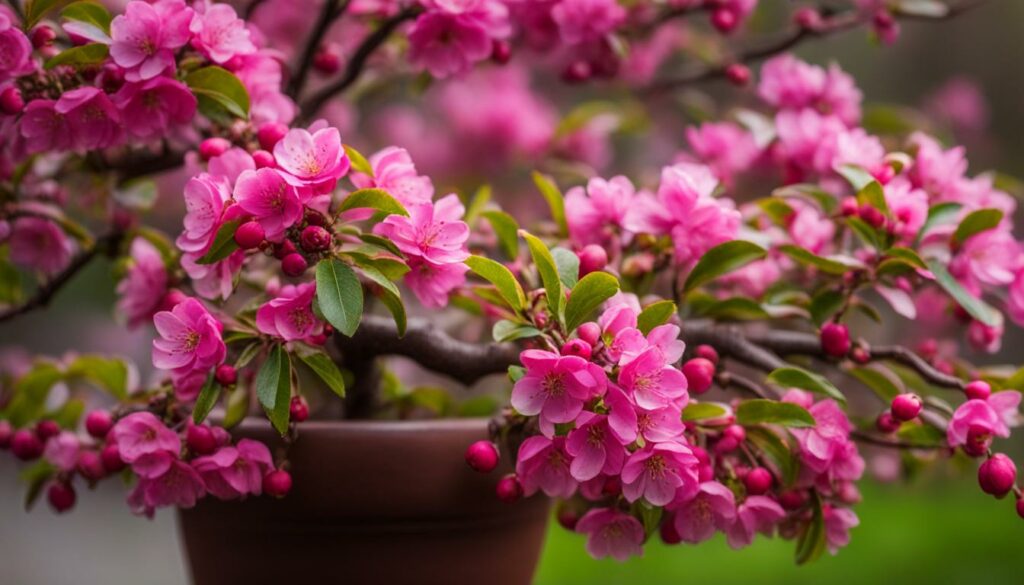Welcome to the world of Bonsai Tree Species! In this article, we will take a closer look at the magnificent crabapple bonsai, a miniature tree with delicate features that is sure to captivate any gardening enthusiast. With its bright colors and dainty beauty, it is no wonder that crabapple bonsai is an art-form loved by many.
The crabapple bonsai is a fruiting bonsai that is a delight to cultivate and maintain. With its Malus bonsai variety, you can enjoy beautiful flowers and fruits that add to the charm of this unique bonsai species.
Key Takeaways:
- The crabapple bonsai is a miniature tree with delicate features
- It is a fruiting bonsai with a Malus bonsai variety that produces beautiful flowers and fruits
- The crabapple bonsai is an art-form loved by many gardening enthusiasts
- Cultivating and maintaining a crabapple bonsai requires various techniques such as pruning, wiring, and soil management
- Selecting the perfect crabapple bonsai involves considerations such as age, trunk thickness, and overall health
What is a Crabapple Bonsai?
When you think of bonsai, you may picture a petite, perfectly pruned miniature tree. However, not all bonsai species are created equal. The crabapple bonsai stands out in the world of bonsai art for its unique qualities and distinct beauty.
As its name implies, the crabapple bonsai is a miniature tree that is cultivated from crabapple varieties. It is meticulously trained and pruned to reflect the intricate artistry of bonsai, with its delicate branches and trunk carefully shaped to match the proportions of a full-sized tree.
What sets the crabapple bonsai apart from other bonsai species is its fascinating transformation throughout the seasons. In spring, it bursts with stunning blossoms, and in autumn, it is adorned with small, colorful apples, adding a charming touch to any bonsai collection.
Fun Fact: Did you know that there are over 45 different varieties of crabapple trees that can be trained as bonsai?
To grow a crabapple bonsai requires patience, skill, and a deep appreciation for the art of bonsai. These miniature trees can take several years to reach maturity and require regular pruning, shaping, and training to maintain their desired form.
Despite the challenges, the beauty and allure of crabapple bonsai make it a coveted addition to any bonsai collection, and a testament to the skill and dedication of bonsai enthusiasts.
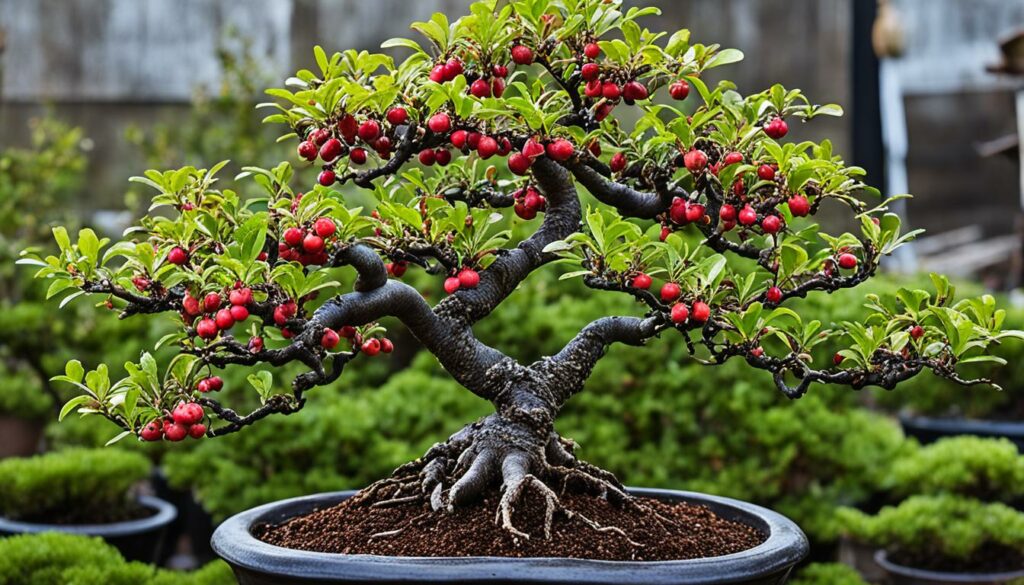
The Allure of Fruiting Bonsai
As you explore the world of bonsai, you’ll quickly discover the enchanting beauty of fruiting bonsai. These miniature fruit trees add a special touch to the art form and create a unique and memorable addition to any collection. Among the most popular fruiting bonsai species is the crabapple, which offers a stunning display of delicate blossoms in the spring followed by miniature fruit in the summer and fall.
| Crabapple Varieties Suitable for Fruiting Bonsai | Description |
|---|---|
| Profusion | Compact tree with pink flowers and small red crabapples. |
| Prairiefire | Stunning deep pink flowers and bright red crabapples. |
| Centurion | Upright tree with pink and white flowers and attractive red fruit. |
The key to nurturing a fruiting crabapple bonsai lies in selecting the right variety and mastering the techniques involved in its cultivation. When selecting a crabapple for fruiting bonsai, look for a young tree with small leaves and good branching. These trees can be trained to grow into the desired Bonsai shape, while still producing fruit each year. In addition to regular bonsai care techniques such as pruning and shaping, fruiting bonsai also require appropriate sunlight, water, and soil nutrients to thrive.
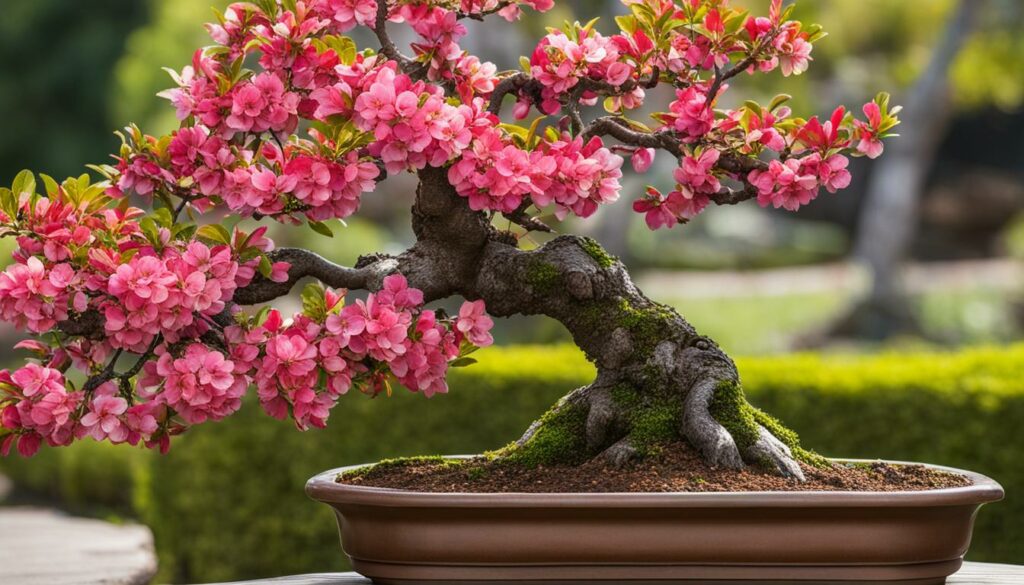
As you gain experience and knowledge in cultivating fruiting bonsai, you may find the rewards are worth the effort. The sight of miniature fruit trees in your collection can evoke a sense of wonder and joy, reminding us of the beauty of nature in a miniature world.
The Beauty of Malus Bonsai
Malus Bonsai, also known as flowering crabapple, is a stunning ornamental tree that can be cultivated as a bonsai. One of the unique features of Malus Bonsai is its elegant blossoms that bloom in late spring and early summer, adding a touch of beauty and delight to any collection.
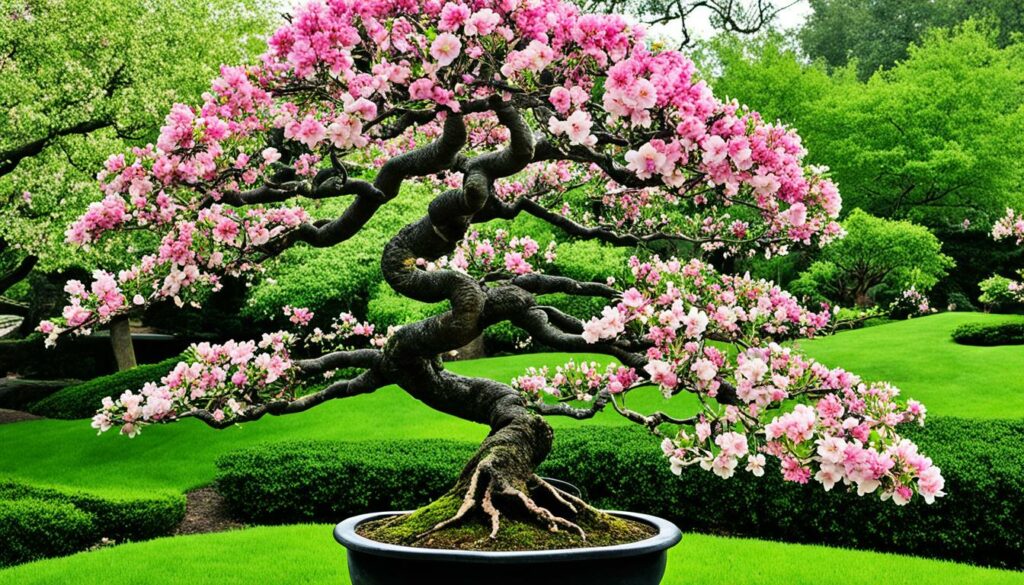
The vibrant foliage of Malus Bonsai also adds to its allure. With leaves that range from shades of green to bronze and even burgundy, this bonsai species is a true feast for the eyes.
Proper care and maintenance are crucial to keep your Malus Bonsai thriving. Ensure that your bonsai receives the right amount of sunlight, water, and nutrients. Regular pruning and repotting are also essential for the growth and development of your bonsai.
Selecting the Perfect Crabapple Bonsai
Choosing the right crabapple bonsai is essential for creating a beautiful and thriving collection. When selecting a bonsai from a nursery, there are several key characteristics to consider:
Age
The age of a crabapple bonsai is an essential factor to consider when making a purchase. Younger trees are preferable as they allow for more shaping and styling possibilities, which are fundamental elements of the bonsai aesthetic.
Trunk Thickness
The trunk thickness of your desired crabapple bonsai is another crucial consideration. The trunk should be thick, proportional to the tree’s height, and show evidence of tapering towards the apex.
Overall Health
The overall health of your crabapple bonsai is critical in ensuring its longevity. Look out for signs of decay, infestations, or diseases, such as discolored leaves, dead branches, or soft spots in the trunk.
Once you have selected your desired crabapple bonsai, it’s essential to provide it with the right growing conditions to ensure optimal growth and health. Consider repotting the bonsai and providing it with the appropriate soil mix to foster healthy root growth.
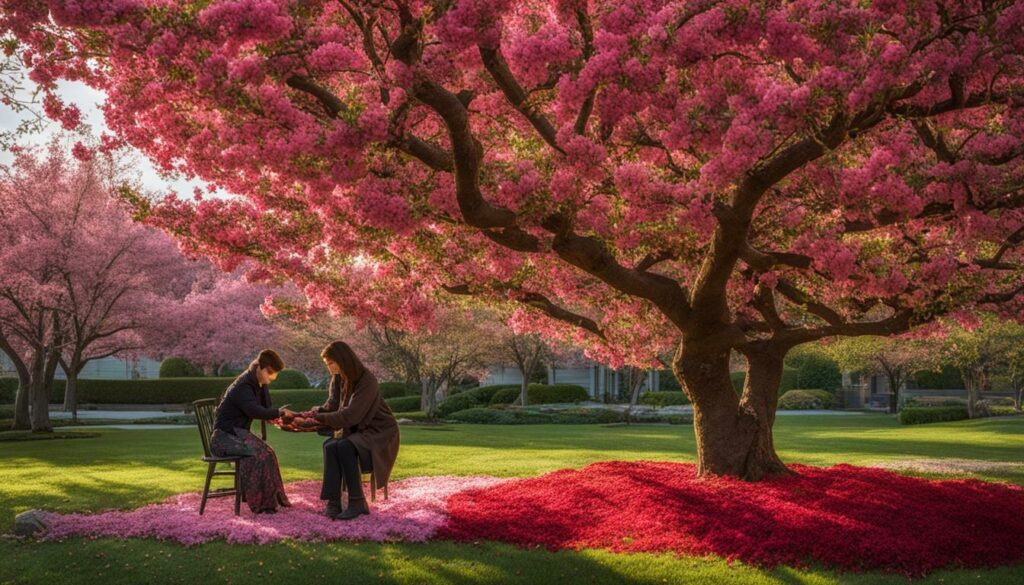
“Selecting the perfect crabapple bonsai is a process that requires careful consideration, but the result is a stunning and harmonious addition to any bonsai collection.”
Cultivating and Shaping Your Crabapple Bonsai
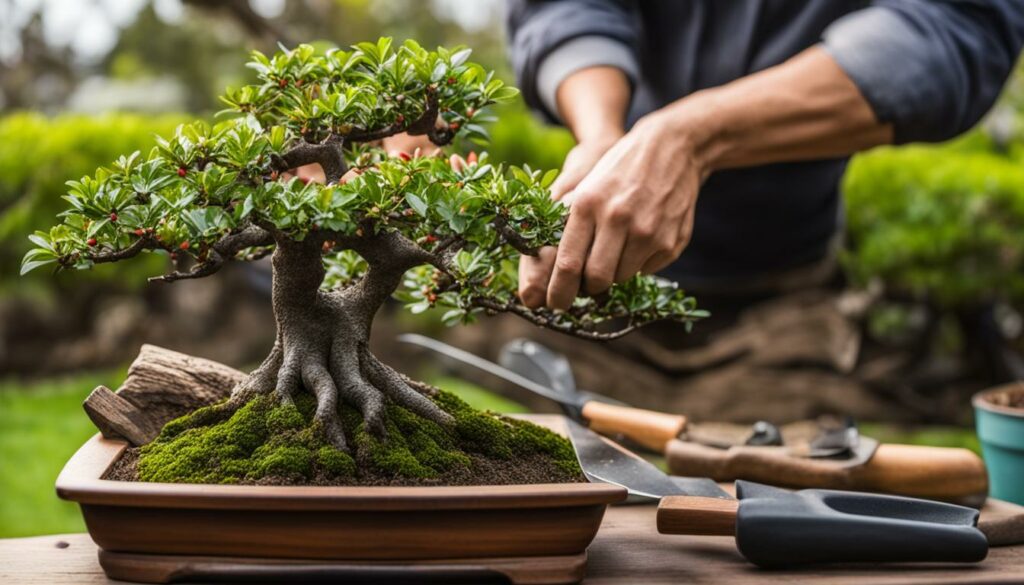
Creating a thriving crabapple bonsai requires proper care and maintenance. By following a few key techniques, you can ensure your bonsai stays healthy and vibrant.
Crabapple Bonsai Care
When caring for your crabapple bonsai, it’s important to keep the following factors in mind:
- Watering: Bonsai trees require consistent watering, and the crabapple species is no exception. Be sure to water your crabapple bonsai regularly, keeping the soil moist but not waterlogged.
- Fertilizing: Fertilize your crabapple bonsai regularly during the growing season, using a balanced fertilizer rich in nitrogen, phosphorus, and potassium.
- Light: Crabapple bonsai trees thrive in full sun, so be sure to provide your tree with ample light. If necessary, supplement with artificial lighting.
- Temperature: Crabapple bonsai trees require cooler temperatures during the winter months. Keep your tree between 35-45°F (1-7°C) during this time.
Shaping Techniques and Pruning
Shaping and pruning are essential techniques to maintain the desired silhouette and structure of your crabapple bonsai. Here are some techniques specific to the crabapple species:
| Technique | Description |
|---|---|
| Pruning: | Prune your crabapple bonsai regularly to promote new growth and maintain the desired shape. Use scissors or shears to remove branches and foliage, being careful not to damage the trunk. |
| Wiring: | Use wire to shape the branches of your crabapple bonsai, carefully wrapping the wire around the branch and bending it into the desired shape. Be sure to remove the wire once the branch has set in its new position. |
| Styling: | Choose a styling technique based on the desired effect, such as formal or informal upright, cascade, semi-cascade, or windswept. Be sure to research the specific techniques needed for your chosen style. |
By following these crucial techniques for crabapple bonsai care, shaping, and pruning, you can enjoy a miniature masterpiece in your own home.
Repotting and Soil Requirements for Crabapple Bonsai
Repotting your crabapple bonsai is crucial to ensure its continued growth and vitality. A general rule of thumb is to repot your bonsai every one to two years, depending on the age and size of your tree. When you notice the roots are circling around the bottom of the pot, it’s time to repot.
The best time to repot your crabapple bonsai is in the early spring, just before the buds begin to open. This will give your tree ample time to recover from the shock of transplantation before the growing season begins.
The soil mix for your crabapple bonsai should be well-draining to promote healthy root growth. A recommended soil mix for crabapple bonsai is 50% grit or sand, 25% peat moss, and 25% akadama or pumice. Mixing in some organic material like compost can also be beneficial.
Root pruning is an essential step in the repotting process and is crucial for promoting optimal growth. Before repotting, remove the tree from its current pot and trim the roots using sharp, clean scissors. Cut away any dead or damaged roots, and shorten the remaining roots by about a third. This will encourage new growth and help prevent root-bound conditions.
When repotting your crabapple bonsai, select a pot that is slightly larger than the previous one and has good drainage holes. Insert a layer of screening over the drainage holes to prevent soil from falling out. Fill the pot halfway with soil mix, place your tree in the pot, and add soil until the tree is firmly anchored in place.
Pristine Pruning: Crabapple Bonsai Maintenance
To keep your crabapple bonsai in pristine condition, regular maintenance is essential. Proper pruning, seasonal care, and protection against pests and diseases are all crucial for the health and beauty of your bonsai.
Pruning Techniques
Pruning is a crucial aspect of maintaining your crabapple bonsai. Regular pruning can help shape your bonsai and encourage healthy growth. Some pruning techniques to consider:
- Pinching: Use your fingers to pinch off small shoots and buds to maintain the shape of your bonsai.
- Cutting: Use sharp, clean shears to make precise cuts on thicker branches and foliage. Cut at a 45-degree angle to promote healing.
- Wiring: If you want to shape your bonsai, you may need to use wiring techniques to train it. Be cautious not to damage the branches when wiring.
Remember to prune your crabapple bonsai regularly to maintain its shape and encourage healthy growth.
Seasonal Care
The seasonal care of your bonsai is also essential to its health and beauty. Here are some tips for each season:
| Season | Care |
|---|---|
| Spring | Water generously as soon as buds begin to show. Fertilize every two weeks using a balanced fertilizer. Protect against late frosts. |
| Summer | Water daily and more frequently during hot, dry weather. Fertilize every three weeks using a balanced fertilizer. Protect against pests. |
| Fall | Reduce watering gradually as the weather cools. Fertilize once every month. Protect against early frosts. |
| Winter | Water sparingly. Do not fertilize. Protect from freezing temperatures. |
By following these seasonal care tips, you can ensure your crabapple bonsai stays healthy and beautiful all year long.
Pests and Diseases
Protecting your bonsai against pests and diseases is also vital to its health. Some common pests and diseases to be aware of include:
- Aphids: Treat with insecticidal soap or horticultural oil.
- Spider mites: Treat with wettable sulfur or horticultural oil.
- Fungal diseases: Treat with a fungicide to prevent the spread of fungus.
Be sure to keep a keen eye on your crabapple bonsai for any signs of pests or diseases. Addressing these issues early is key to keeping your bonsai healthy and thriving.
Showcasing Your Crabapple Bonsai: Display and Styling Tips
Now that you have cultivated and cared for your crabapple bonsai, it’s time to showcase its unique beauty through creative display and styling techniques. Follow these tips to enhance the aesthetic appeal of your bonsai:
- Choose the right bonsai pot: The right pot can make all the difference when displaying your bonsai. Consider the size, shape, and color of the pot, and make sure it complements the tree’s style and character.
- Select accent plants: Accent plants can help create a harmonious composition and accentuate the beauty of your bonsai. Choose plants that are proportionate to your bonsai and complement its foliage and flowers.
- Create a theme: Use the bonsai and accent plants to create a theme or a story that enhances the beauty of your display.
- Embrace negative space: Negative space can help create a balance and harmony in your display. Let the bonsai and accent plants breathe, and avoid overcrowding the display by including too many elements.
Styling Your Crabapple Bonsai:
Styling your crabapple bonsai is as much an art form as cultivating it. Consider the following tips when styling your bonsai:
| Styling technique | Description |
|---|---|
| Pruning: | Cut back the branches to create the desired shape and silhouette of the tree. |
| Wiring: | Use wire to shape the branches and trunk of the tree. |
| Deadwood carving: | Create unique shapes and textures by carving the deadwood of the tree. |
Remember to consider the overall style and character of your crabapple bonsai before styling it. Aim to create an organic and natural shape, and don’t be afraid to experiment and try new techniques to create a unique and beautiful tree.
Growing Your Passion for Crabapple Bonsai
Now that you have learned the ins and outs of cultivating and caring for your crabapple bonsai, it’s time to connect with other bonsai enthusiasts in the bonsai community. By sharing your experiences and knowledge with fellow enthusiasts, you can grow your passion and appreciation for this ancient art form.
Join a local bonsai group or club to meet like-minded individuals who share your love for bonsai. Attend bonsai shows and exhibitions to showcase your hard work and learn from other enthusiasts. You can even engage in online forums and social media groups to stay connected with the bonsai community from the comfort of your own home.
Continuing education is also essential to grow your knowledge and skillset in bonsai cultivation. Attend workshops, seminars, and conferences to learn from experts in the field and discover new techniques to apply to your crabapple bonsai. Take advantage of online resources such as bonsai blogs, forums, and instructional videos to deepen your understanding and appreciation for bonsai.
As you continue to learn and grow your passion for crabapple bonsai, remember to enjoy the journey of this ancient art form. With dedication, patience, and ongoing education, you can cultivate a miniature marvel that brings the beauty of spring right to your tabletop.
FAQ
What is a crabapple bonsai?
A crabapple bonsai is a miniature tree that has been cultivated and shaped using the art of bonsai. It is a smaller version of a crabapple tree, known for its delicate flowers and vibrant fruits.
What makes crabapple bonsai different from other bonsai species?
Crabapple bonsai is unique due to its beautiful blossoms and vibrant fruits. They require specific care and maintenance to ensure proper growth and flowering. Additionally, the crabapple bonsai tree can be trained to have its branches spread outwards or contorted to create visually interesting shapes.
Can a crabapple bonsai produce fruits?
Yes, a properly cared for and healthy crabapple bonsai can produce fruits. However, keep in mind that the fruits on a bonsai tree will be smaller in size compared to a full-sized crabapple tree. The miniature fruits add a charming touch to the overall aesthetic of the bonsai.
How do I select the perfect crabapple bonsai for my collection?
When selecting a crabapple bonsai, it is important to consider factors such as the tree’s age, trunk thickness, overall health, and its suitability for your desired style and vision. Visiting a trusted bonsai nursery and seeking the assistance of experts can help you find the perfect specimen for your collection.
How do I care for my crabapple bonsai?
Caring for a crabapple bonsai involves regular watering, adequate sunlight, and proper pruning to maintain its shape and health. Additionally, providing the right soil mix and repotting the bonsai when needed are vital for its overall well-being.
Can I shape my crabapple bonsai?
Yes, you can shape and style your crabapple bonsai using pruning and wiring techniques. These techniques help create the desired form, structure, and silhouette of the bonsai tree. It is essential to learn proper techniques and seek guidance from experienced bonsai practitioners to avoid damaging the tree.
When should I repot my crabapple bonsai?
Repotting a crabapple bonsai is typically done every two to three years, during the tree’s dormant season. This allows for root pruning and replenishing the soil, promoting healthy growth and preventing root-bound issues.
How do I maintain the health of my crabapple bonsai?
Maintaining the health of your crabapple bonsai involves regular pruning to remove dead branches, proper watering to prevent over or under-watering, and protecting it from pests and diseases. Providing the bonsai with adequate sunlight and nutrients through proper fertilization is also crucial for its well-being.
Can I display my crabapple bonsai indoors?
While crabapple bonsai can be brought indoors for temporary display, they typically require outdoor conditions to thrive. They need adequate sunlight and a natural seasonal cycle to bloom and fruit properly. If kept indoors, ensure they receive enough light and humidity to simulate an outdoor environment.
How can I connect with other bonsai enthusiasts?
You can connect with other bonsai enthusiasts by joining bonsai clubs, attending workshops and seminars, and participating in online forums and communities. These platforms provide opportunities for learning, sharing experiences, and exchanging tips and advice with fellow bonsai lovers.
